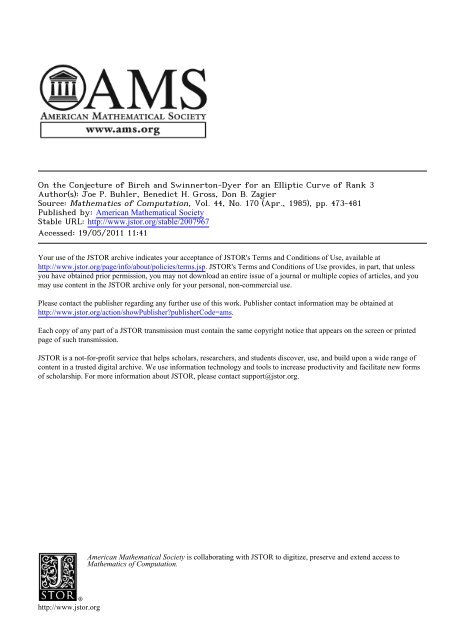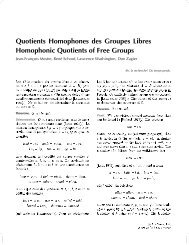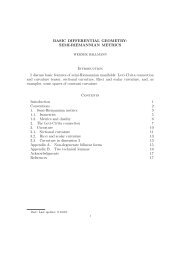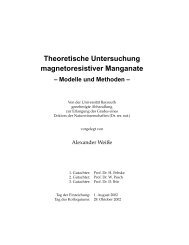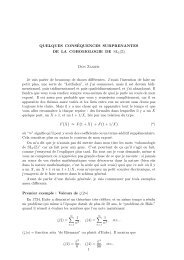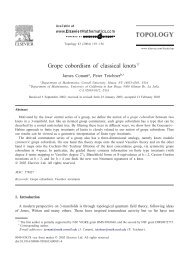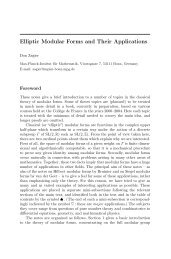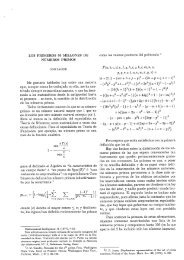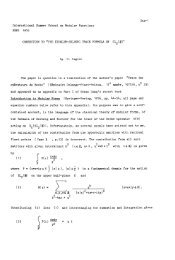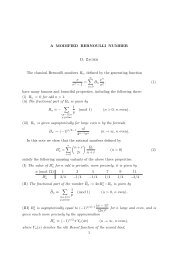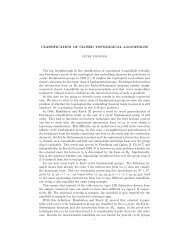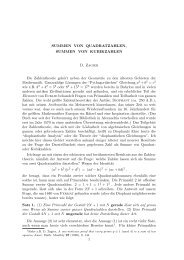On the Conjecture of Birch and Swinnerton-Dyer for an ... - Up To
On the Conjecture of Birch and Swinnerton-Dyer for an ... - Up To
On the Conjecture of Birch and Swinnerton-Dyer for an ... - Up To
You also want an ePaper? Increase the reach of your titles
YUMPU automatically turns print PDFs into web optimized ePapers that Google loves.
<strong>On</strong> <strong>the</strong> <strong>Conjecture</strong> <strong>of</strong> <strong>Birch</strong> <strong><strong>an</strong>d</strong> <strong>Swinnerton</strong>-<strong>Dyer</strong> <strong>for</strong> <strong>an</strong> Elliptic Curve <strong>of</strong> R<strong>an</strong>k 3Author(s): Joe P. Buhler, Benedict H. Gross, Don B. ZagierSource: Ma<strong>the</strong>matics <strong>of</strong> Computation, Vol. 44, No. 170 (Apr., 1985), pp. 473-481Published by: Americ<strong>an</strong> Ma<strong>the</strong>matical SocietyStable URL: http://www.jstor.org/stable/2007967 .Accessed: 19/05/2011 11:41Your use <strong>of</strong> <strong>the</strong> JSTOR archive indicates your accept<strong>an</strong>ce <strong>of</strong> JSTOR's Terms <strong><strong>an</strong>d</strong> Conditions <strong>of</strong> Use, available at .http://www.jstor.org/page/info/about/policies/terms.jsp. JSTOR's Terms <strong><strong>an</strong>d</strong> Conditions <strong>of</strong> Use provides, in part, that unlessyou have obtained prior permission, you may not download <strong>an</strong> entire issue <strong>of</strong> a journal or multiple copies <strong>of</strong> articles, <strong><strong>an</strong>d</strong> youmay use content in <strong>the</strong> JSTOR archive only <strong>for</strong> your personal, non-commercial use.Please contact <strong>the</strong> publisher regarding <strong>an</strong>y fur<strong>the</strong>r use <strong>of</strong> this work. Publisher contact in<strong>for</strong>mation may be obtained at .http://www.jstor.org/action/showPublisher?publisherCode=ams. .Each copy <strong>of</strong> <strong>an</strong>y part <strong>of</strong> a JSTOR tr<strong>an</strong>smission must contain <strong>the</strong> same copyright notice that appears on <strong>the</strong> screen or printedpage <strong>of</strong> such tr<strong>an</strong>smission.JSTOR is a not-<strong>for</strong>-pr<strong>of</strong>it service that helps scholars, researchers, <strong><strong>an</strong>d</strong> students discover, use, <strong><strong>an</strong>d</strong> build upon a wide r<strong>an</strong>ge <strong>of</strong>content in a trusted digital archive. We use in<strong>for</strong>mation technology <strong><strong>an</strong>d</strong> tools to increase productivity <strong><strong>an</strong>d</strong> facilitate new <strong>for</strong>ms<strong>of</strong> scholarship. For more in<strong>for</strong>mation about JSTOR, please contact support@jstor.org.Americ<strong>an</strong> Ma<strong>the</strong>matical Society is collaborating with JSTOR to digitize, preserve <strong><strong>an</strong>d</strong> extend access toMa<strong>the</strong>matics <strong>of</strong> Computation.http://www.jstor.org
MATHEMATICS OF COMPUTATIONVOLUME 44, NUMBER 170APRII. 1985, PAGES 473-481<strong>On</strong> <strong>the</strong> <strong>Conjecture</strong> <strong>of</strong> <strong>Birch</strong> <strong><strong>an</strong>d</strong> <strong>Swinnerton</strong>-<strong>Dyer</strong><strong>for</strong> <strong>an</strong> Elliptic Curve <strong>of</strong> R<strong>an</strong>k 3By Joe P. Buhler, Benedict H. Gross <strong><strong>an</strong>d</strong> Don B. ZagierAbstract. The elliptic curve y2 = 4x3 - 28x + 25 has r<strong>an</strong>k 3 over Q. Assuming <strong>the</strong> Weil-T<strong>an</strong>iyama conjecture <strong>for</strong> this curve, we show that its L-series L(s) has a triple zero at s = 1<strong><strong>an</strong>d</strong> compute lim, _I L(s)/(s - 1)3 to 28 decimal places; its value agrees with <strong>the</strong> product <strong>of</strong><strong>the</strong> regulator <strong><strong>an</strong>d</strong> real period, in accord<strong>an</strong>ce with <strong>the</strong> <strong>Birch</strong>-<strong>Swinnerton</strong>-<strong>Dyer</strong> conjecture if IIIis trivial.The object <strong>of</strong> this note is to verify <strong>the</strong> conjecture <strong>of</strong> <strong>Birch</strong> <strong><strong>an</strong>d</strong> <strong>Swinnerton</strong>-<strong>Dyer</strong>numerically (to high accuracy) <strong>for</strong> <strong>the</strong> elliptic curve(1) E :y2 = 4x3 - 28x + 25.The conductor <strong>of</strong> E is 5077, which is apparently <strong>the</strong> smallest conductor <strong>for</strong> a curve<strong>of</strong> r<strong>an</strong>k 3 over Q. Since previous accurate numerical verifications were done <strong>for</strong>modular curves <strong>of</strong> r<strong>an</strong>k 0 or 1, <strong><strong>an</strong>d</strong> <strong>the</strong>se c<strong>an</strong> now be confirmed <strong>the</strong>oretically [2], [4],it seemed desirable to test <strong>the</strong> conjecture <strong>for</strong> a curve <strong>of</strong> larger r<strong>an</strong>k.We assume some familiarity with <strong>the</strong> <strong>the</strong>ory <strong>of</strong> elliptic curves; good references are[3] <strong><strong>an</strong>d</strong> [5].1. The C<strong>an</strong>onical Height Function. <strong>On</strong>e <strong>of</strong> <strong>the</strong> main ingredients in <strong>the</strong> <strong>Birch</strong>-<strong>Swinnerton</strong>-<strong>Dyer</strong> <strong>for</strong>mula is <strong>the</strong> regulator, i.e., <strong>the</strong> determin<strong>an</strong>t <strong>of</strong> <strong>the</strong> matrix expressing<strong>the</strong> c<strong>an</strong>onical height pairing on E(Q) ? R with respect to a Z-basis <strong>of</strong>E(Q)/E(Q) tors- In this section we describe how to calculate <strong>the</strong> c<strong>an</strong>onical height <strong>of</strong> apoint P e E(Q).We first recall <strong>the</strong> definition. The global minimal model <strong>for</strong> E has <strong>the</strong> <strong>for</strong>m(2) y2 +y=x3-7x+6,obtained by replacing y by 2y + 1 in (1) <strong><strong>an</strong>d</strong> dividing by 4; this equation hasdiscrimin<strong>an</strong>t A\ = 5077. If P E E(Q), <strong>the</strong>n <strong>the</strong> naive height <strong>of</strong> P is defined as(3) h(P) = logmax(lal, b), x(P) = a/b, b > 0, (a, b) = 1(here it does not matter whe<strong>the</strong>r we use model (1) or (2) <strong>for</strong> E, as <strong>the</strong> x-coordinatesare <strong>the</strong> same); <strong>the</strong> c<strong>an</strong>onical height is <strong>the</strong> unique quadratic <strong>for</strong>m h on E(Q) ? R suchthat h (P) - h (P) is bounded, <strong><strong>an</strong>d</strong> <strong>the</strong> c<strong>an</strong>onical height pairing is <strong>the</strong> associatedbilinear <strong>for</strong>m (P, P') = ((h(P + P') - h(P) - h(P')). The definition <strong>of</strong> h immediatelyimplies <strong>the</strong> <strong>for</strong>mula h (P) = limn n - 2h (nP), but this is not convenient<strong>for</strong> calculations. A <strong>for</strong>mula which is usable is(4) h (P) = logb + F(x(P)),Received March 20, 1984; revised June 11, 1984.1980 Ma<strong>the</strong>matics Subject Classification. Primary 14K07, 14G10.473?01985 Americ<strong>an</strong> Ma<strong>the</strong>matical Society0025-5718/85 $1.00 + $.25 per page
474 JOE. P. BUHLER, BENEDICT H. GROSS AND DON B. ZAGIERwhere b denotes <strong>the</strong> denominator <strong>of</strong> x(P) as in (3) <strong><strong>an</strong>d</strong> F(x) is <strong>the</strong> real-valuedfunction defined by(5)00F(x) = log|x| + E 4-n-1logz,n~~~~~~~~~~~~~~l=0(5) ~+14 50 49 x4 + 14X2 - 50x + 49x,1 Xn Xn4x3 - 28xn+ 25Near x = 0 <strong>the</strong> first two terms in (5) become infinite, but we c<strong>an</strong> combine <strong>the</strong>m toobtain(6) F(x)=1log(x4 + 14X2-50x~~~~~~~~~~~~00+ 49) + E 4-n-1logztt= 1a <strong>for</strong>mula which now makes sense <strong>for</strong> all x. Note that <strong>the</strong> <strong>for</strong>mula relating xn+l to xnis <strong>the</strong> <strong>for</strong>mula relating x(2P) to x(P) <strong>for</strong> P E E, so that xn = x(2 P). In particular,x,l > e3 = 1.946... <strong>for</strong> n > 1, where e1 < e2 < e3 denote <strong>the</strong> roots <strong>of</strong> <strong>the</strong> polynomial4x3 - 28x + 25, so zn lies between 1 <strong><strong>an</strong>d</strong> 1.328 ... <strong><strong>an</strong>d</strong> log zn between 0 <strong><strong>an</strong>d</strong>0.284.... There<strong>for</strong>e <strong>the</strong> series in (5) or (6) converges very rapidly <strong><strong>an</strong>d</strong> we c<strong>an</strong>calculate h ( P) to <strong>an</strong>y desired degree <strong>of</strong> accuracy.Formula (4) is <strong>the</strong> specialization to our case <strong>of</strong> a general recipe <strong>of</strong> Tate [6] <strong>for</strong>computing heights; indeed, F(x(P)) is Tate's <strong>for</strong>mula <strong>for</strong> <strong>the</strong> infinite component <strong>of</strong>( P, P) while ord,(b)log p (p prime) gives <strong>the</strong> p-component <strong>of</strong> <strong>the</strong> c<strong>an</strong>onical height(even <strong>for</strong> <strong>the</strong> prime p = 5077 <strong>of</strong> bad reduction, since <strong>the</strong> fiber <strong>of</strong> <strong>the</strong> Neron model atp is irreducible). However, Tate's result, although quoted in <strong>the</strong> literature, has notyet been published, so we give a direct pro<strong>of</strong> <strong>of</strong> (4) in our case. By virtue <strong>of</strong> <strong>the</strong>definition, it will suffice to show that <strong>the</strong> expression on <strong>the</strong> right-h<strong><strong>an</strong>d</strong> side <strong>of</strong> (4)differs by a bounded amount from h (P) <strong><strong>an</strong>d</strong> is multiplied by 4 if P is replaced by2P. By <strong>the</strong> <strong>for</strong>mula already cited, replacing P by 2P replaces x(P) = a/b byx(2P) = a*/b*, wherea* = a4 + 14a2b2- 50ab3 + 49b4, b* = 4a3b- 28ab3 + 25b4.We claim that b* is <strong>the</strong> exact denominator <strong>of</strong> x(2P). Indeed, <strong>an</strong> elementarycalculation with g.c.d.'s shows that (a*, b*) = 1 <strong>for</strong> <strong>an</strong>y integers a, b with (a, b) = 1unless a 92b (mod5077), in which case 50771(a*, b*). But this c<strong>an</strong>not happenhere, since 4x3 - 28x + 25 = 4(x - 92)2(x + 184) + 5077(20x - 1227) would bedivisible by 5077 but not by 50772 if x were 92 (mod 5077) <strong><strong>an</strong>d</strong> hence, could notbe a square. (This is <strong>an</strong> elementary restatement <strong>of</strong> <strong>the</strong> fact that <strong>the</strong> Neron model at5077 has only one component.) <strong>On</strong> <strong>the</strong> o<strong>the</strong>r h<strong><strong>an</strong>d</strong>, replacing P by 2P replaces xn, znby x,n+1, Zn+ in (5), soF(x(2P)) = logjx(2P)1 + E 4-n-1 log zn+n=000= log|x(2P)| + 4(F(x) -log|x -4-4llog z0) (x = x(P))= 4F(x) - log(4x3 - 28x + 25)= 4(F(x(P)) + log b) - log b*,
AN ELLIPTIC CURVE OF RANK 3 475proving <strong>the</strong> second assertion. As to <strong>the</strong> difference <strong>of</strong> h <strong><strong>an</strong>d</strong> h, we c<strong>an</strong> write (3) ash(P) = log b + log max( I a I/b, 1), soh(P) - h(P) = F(x) - logmax(|x|, 1) (x = x(P)).If x > e3 = 1.94... is in <strong>the</strong> right-h<strong><strong>an</strong>d</strong> component <strong>of</strong> E(R), <strong>the</strong>n <strong>the</strong> same is true<strong>for</strong> all x,1 (n _ 0), so 1 _ z, ? 1.328 ... <strong>for</strong> all n in (5) <strong><strong>an</strong>d</strong> <strong>the</strong>re<strong>for</strong>e000 ? F(x)-log x _ E 4- n-1 log(l.328 ...) = 0.0947....nl =0The o<strong>the</strong>r component el ? x ? e2 <strong>of</strong> E(R) is compact <strong><strong>an</strong>d</strong> we easily find <strong>the</strong>minimum <strong><strong>an</strong>d</strong> maximum <strong>of</strong> F(x) - log max(IxI, 1) <strong>the</strong>re to be 0.4006 ... <strong><strong>an</strong>d</strong> 1.205 ...(obtained <strong>for</strong> x = el <strong><strong>an</strong>d</strong> x = -1, respectively; see Figure 1). Hence in all cases wehave(7) h(P) ? h'(P) ? h(P) + 1.205....This completes <strong>the</strong> pro<strong>of</strong> <strong>of</strong> (4). We remark that <strong>the</strong> difference between <strong>the</strong> naive<strong><strong>an</strong>d</strong> c<strong>an</strong>onical heights on elliptic curves has been studied by several authors (cf. [7]<strong><strong>an</strong>d</strong> <strong>the</strong> literature cited <strong>the</strong>re) but that <strong>the</strong> inequality (7) is much sharper th<strong>an</strong> <strong>the</strong>one obtained by specializing <strong>the</strong>ir results, suggesting that some improvements in <strong>the</strong>general case may still be possible.e~ ~ 2ee2 e34~~~~-3' -2 -1 0 1 2' 3 4FIGURE 1The functions F(x) <strong><strong>an</strong>d</strong> log max( IxI, 1)2. The Mordell-Weil Group <strong><strong>an</strong>d</strong> <strong>the</strong> Regulator. Let Np (p 0 5077) denote <strong>the</strong>cardinality <strong>of</strong> E(Z/pZ), i.e., 1 plus <strong>the</strong> number <strong>of</strong> solutions <strong>of</strong> (2) in integers modulop. Then IE(Q)torsl must divide Np <strong>for</strong> allp > 2; since N3 = 7 <strong><strong>an</strong>d</strong> N5 = 10 it followsthat E(Q) is free Abeli<strong>an</strong>. We claim that it is <strong>of</strong> r<strong>an</strong>k 3, generated by <strong>the</strong> three pointsP0 = (0, 2), P1 = (1, 0), P2 = (2, 0).It follows from Eq. (7) that <strong>the</strong>se are <strong>the</strong> only points (up to sign) with c<strong>an</strong>onicalheight less th<strong>an</strong> 1, since h(P) ? h(P) ? 1 implies (cf. (3)) max(IaI, b) ? e <strong><strong>an</strong>d</strong> hence
476 JOE. P. BUHLER, BENEDICT H. GROSS AND DON B. ZAGIER(since b is always a square) b = 1, a E {-2, -1, 0, 1, 2}; <strong>of</strong> <strong>the</strong>se five c<strong><strong>an</strong>d</strong>idates, onlya = 0, 1, 2 lead to points with h(P) < 1. <strong>On</strong> <strong>the</strong> o<strong>the</strong>r h<strong><strong>an</strong>d</strong>, one sees by a 2-descent(cf. [1]) that P0, P1, P2 generate E(Q)/2E(Q), which is <strong>of</strong> r<strong>an</strong>k 3 over Z/2Z. Thesetwo facts <strong><strong>an</strong>d</strong> <strong>the</strong> fact that E(Q) is torsion-free imply by <strong>the</strong> usual pro<strong>of</strong> <strong>of</strong> <strong>the</strong>Mordell-Weil <strong>the</strong>orem (cf. <strong>an</strong>y text on elliptic curves) that E(Q) = ZPO + ZP1 + ZP2as claimed. Using <strong>the</strong> algorithm <strong>of</strong> Section 1 we c<strong>an</strong> calculate <strong>the</strong> entries <strong>of</strong> <strong>the</strong>matrix.9909... -.2365... -.2764 ...A = ((P,, P))o_ i,J_
y2 +y =x -7x +6 5-.AN ELLIPTIC CURVE OF RANK 3 477y69~~~~~~-P O-P 1 -P2/4"1P2-P-1-0pr -P2P1-P2 Po+P2~ ~~~~~~p +PoFIGURE 2Integral points on F3. The Real Period. The group E(R) has two connected components. Let wc=dx/(2y + 1) be a Neron differential on E over Z, <strong><strong>an</strong>d</strong> IwI <strong>the</strong> associated measure onE(R). The real period 52 is defined by2 = 0@ = 2 1@E(R)E(R)If we write (0.1) in <strong>the</strong> <strong>for</strong>m y2 = 4(x - el)(x - e2)(x - e3) with e1 < e2< e3we may calculate this period integral using <strong>the</strong> arithmetic-geometric me<strong>an</strong>. This isdefined on two positive real arguments x <strong><strong>an</strong>d</strong> y by M(x, y) = limn,1xn =limn-oyoY where xo=x, yO = y, xn1 = (Xn + yn)/2, yn+l = x . We find(Gauss):(9) u2= 4fodx27T2zTy M(Fe3 -e , e3 e2 M(2.22689...,0.938503 ..)= 4.151687983086933049884175683507286....4. The L-Series. The L-series <strong>for</strong> E over Q is given by <strong>an</strong> Euler product whichconverges in <strong>the</strong> right half-pl<strong>an</strong>e Re(s) > 3/2:L(E, s) = (1 + 5077-s)-1 r (1 - ap-s + pl2s)a = np * 5077 ni = 1
478 JOE. P. BUHLER, BENEDICT H. GROSS AND DON B. ZAGIERwhere ap(p 0 5077) equals p + 1 - N with Np as in Section 2. We haveA(s):= Ns/2(27r)sF(s)L(E, s)= |')Ys-dywhere N = 5077 <strong><strong>an</strong>d</strong> f(iT) = r= l<strong>an</strong>e 2e2inT (rT E C, Im(iT)> 0). The Weil-T<strong>an</strong>iyamaconjecture states thatf(T) is a cusp <strong>for</strong>m <strong>of</strong> weight 2 on <strong>To</strong>(N). We will assume thatit is true. (This could be checked by a finite computation in <strong>the</strong> 422-dimensionalspace <strong>of</strong> cusp <strong>for</strong>ms <strong>of</strong> this weight <strong><strong>an</strong>d</strong> level, but we have not carried it out; thus thisnote could more properly be described as a simult<strong>an</strong>eous numerical verification <strong>of</strong><strong>the</strong> <strong>Birch</strong>-<strong>Swinnerton</strong>-<strong>Dyer</strong> <strong><strong>an</strong>d</strong> Weil-T<strong>an</strong>iyama conjectures.) Thenf(T) satisfies <strong>the</strong>functional equation f(-l/NT)= NT 2f (T) <strong><strong>an</strong>d</strong> <strong>the</strong> <strong>an</strong>alytic continuation <strong><strong>an</strong>d</strong> functionalequation <strong>of</strong> L(E, s) follow:(10) A(s) = f( j )(ys -y S) dy = -A(2-s).In particular, <strong>the</strong> order <strong>of</strong> L(E, s) at s = 1 is odd <strong><strong>an</strong>d</strong> <strong>the</strong> rth derivative (r ? 1 odd)is given byA(r)(1) = 2f f( )(logy)rdy000= 2 E <strong>an</strong> fe-27nY/vN(logy)rdy.ii=1 1If A (s) v<strong>an</strong>ishes to order > r at s = 1, <strong>the</strong>n integrating (11) once by parts gives2(12) L(r)() (r)() = 2r! <strong>an</strong>P t)A=1r GwhereG .(x ) = (rJ?e - Y(log y) - dy (r _ )______0Vr 1 dyThe series (12) is rapidly convergent, because Gr(x) - x-re-X as x xQ, so it c<strong>an</strong> beused to compute L(r)(1) if we have a good algorithm to compute Gr(X)*The function GI(x) is <strong>the</strong> familiar exponential integral Jf e- Ydy/y, which c<strong>an</strong>be calculated <strong>for</strong> small x (x < 3) by <strong>the</strong> power seriesGI(x) = log- -Y + E (1)! x' (-y = Euler's const<strong>an</strong>t)x ,i=1 n -n!<strong><strong>an</strong>d</strong> <strong>for</strong> large x (x > 2) by <strong>the</strong> continued fraction exp<strong>an</strong>sionG1(X) =x +e-x1+ 2x + ~~21+I1+ +
AN ELLIPTIC CURVE OF RANK 3 479Taking 250 terms <strong>of</strong> <strong>the</strong> series in (12) gives L'(1) = 0 to 13 decimal places. But thisimplies that L'(1)= 0 exactly, since <strong>the</strong> main result <strong>of</strong> [2] implies that L'(1) is asimple multiple <strong>of</strong> <strong>the</strong> height <strong>of</strong> some rational point on E ("Heegner point") <strong><strong>an</strong>d</strong>, aswe have seen, E contains no rational points <strong>of</strong> very small nonzero height. Since L(s)has odd order, we have ords= 1 L(s) ? 3.In general, <strong>the</strong> functions Gr(x) satisfy Go(x) = e-x, Gr'(x) = -(1/x)Gr_1(x), soGr(X) = Pr (log 1-) + E r lrn!<strong>for</strong> some polynomial Pr <strong>of</strong> degree r. <strong>To</strong> determine Pr, we use <strong>the</strong> integral representation:(13) Gr(X) = 2 fi | () x- ds <strong>an</strong>yc > 0.(<strong>To</strong> prove (13), we observe that <strong>the</strong> right-h<strong><strong>an</strong>d</strong> side satisfies <strong>the</strong> same recursivedifferential equations as Gr(x) <strong><strong>an</strong>d</strong> tends to zero as x -> ox.) Shift <strong>the</strong> path <strong>of</strong>integration in (13) to <strong>the</strong> left; <strong>the</strong>n <strong>the</strong> residue at s = -n gives <strong>the</strong> term (-1)" rx "/nr n!<strong><strong>an</strong>d</strong> <strong>the</strong> residue at s = 0 gives Pr(log 1/x). Hence,Since by Euler-Maclaurinr t "71 ??Pr(t) = Yr-rn m where 17(1 + s) - y,1s"7=0 17 = 0we find, <strong>for</strong> r = 3, <strong>the</strong> exp<strong>an</strong>sion00(_)log 17(1 + S) = --ys + E ~ (n=2)SnG3 (X)= +~3 -(log? -v)- + (1h1xPG()=6 (lg-Y 12 (lgx 7 17l3 n3n!which converges <strong>for</strong> all x. Using this we find <strong>the</strong> valueii=1n(14) lim L( 3s-2 -AG(3~s-(I (s - 1) =n 50771.7318499001193006897919750851using <strong>the</strong> terms <strong>for</strong> n < 600 (<strong>the</strong> error made in breaking <strong>of</strong>f <strong>the</strong> series here c<strong>an</strong> beestimated using (12) <strong><strong>an</strong>d</strong> <strong>the</strong> <strong>for</strong>mulas G3(x) X-3e-x <strong><strong>an</strong>d</strong> _jaj11 d(n)rn, whered(n) is <strong>the</strong> number <strong>of</strong> divisors <strong>of</strong> n).The results <strong>of</strong> <strong>the</strong> computations described in this section are summarized in Table2.
480 JOE. P. BUHLER, BENEDICT H. GROSS AND DON B. ZAGIERTABLE 2Computation <strong>of</strong> L'(1) <strong><strong>an</strong>d</strong> L "' (1)n a,, (A)2g 2gn 27 2,'g (7m) 2 'G1 1 1.93741992 2.26675143 3.87483985 4.533502862 -2 1.32687953 .98498602 1.22108079 2.563530823 -3 1.00056041 .54955613 -.78004003 1.464418564 2 .78875755 .34359041 .00871752 1.808008975 -4 .63840821 .22972608 -1.01273562 1.440447256 6 .52596620 .16064962 .03919678 1.761746487 -4 .43894007 .11604939 -.46244901 1.629118618 0 .36992797 .08592813 -.46244901 1.629118619 6 .31419941 .06487957 -.04351647 1.7156247010 8 .26856035 .04977090 .38618010 1.7952581450 -22 .00231086 .00005681 -.00236637 1.73179489100 22 .00001521 .00000013 .00001335 1.73185001250 48 .00000000 .00000000 .00000000 1.731849905. The <strong>Conjecture</strong>. The conjecture <strong>of</strong> <strong>Birch</strong> <strong><strong>an</strong>d</strong> <strong>Swinnerton</strong>-<strong>Dyer</strong> predicts thatord s1L(E, s) = r<strong>an</strong>k(E) = 3 <strong><strong>an</strong>d</strong> thatrnL(E, s)lim ( - = 9 - R - Card(II)sl1 (s- )3where III is <strong>the</strong> (conjecturally finite) Tate-Shafarevich group <strong>of</strong> E over Q. Equations(8) <strong><strong>an</strong>d</strong> (9) giveQ R = 1.731849900119300689791975085060154...which agrees with <strong>the</strong> right-h<strong><strong>an</strong>d</strong> side <strong>of</strong> (14) within <strong>the</strong> accuracy <strong>of</strong> our computationsin Section 3. This strongly suggests that <strong>the</strong> conjecture is true <strong><strong>an</strong>d</strong> thatIII = (1). We have checked, via a 2-descent (cf. [1]), that <strong>the</strong> 2-primary component <strong>of</strong>III is trivial.6. Acknowledgment. We would like to th<strong>an</strong>k J.-F. Mestre <strong>for</strong> some useful suggestions.Note added in pro<strong>of</strong>. It has now been verified by J.-P. Serre <strong><strong>an</strong>d</strong> J.-F. Mestre that<strong>the</strong> curve E satisfies <strong>the</strong> Weil-T<strong>an</strong>iyama conjecture (cf. beginning <strong>of</strong> Section 4), thusunconditionally justifying <strong>the</strong> calculations in this paper.Department <strong>of</strong> Ma<strong>the</strong>maticsReed CollegePortl<strong><strong>an</strong>d</strong>, Oregon 97202Department <strong>of</strong> Ma<strong>the</strong>maticsBrown UniversityProvidence, Rhode Isl<strong><strong>an</strong>d</strong> 02912Max-Pl<strong>an</strong>ck-Institut fMr Ma<strong>the</strong>matikGottfried-Claren-Strasse 265300 Bonn 3, West Germ<strong>an</strong>y<strong><strong>an</strong>d</strong>Department <strong>of</strong> Ma<strong>the</strong>maticsUniversity <strong>of</strong> Maryl<strong><strong>an</strong>d</strong>College Park, Maryl<strong><strong>an</strong>d</strong> 20742
AN ELLIPTIC CURVE OF RANK 3 4811. A. BRUMER & K. KRAMER, "The r<strong>an</strong>k <strong>of</strong> elliptic curves," Duke Math. J., v. 44, 1977, pp. 715-743.2. B. GROSS & D. ZAGIER, "Points de Heegner et derivees de fonctions L," C. R. A cad. Sci. Paris, v.297, 1983, pp. 85-87.3. Y. I. MANIN, "Cyclotomic fields <strong><strong>an</strong>d</strong> modular curves," Uspekhi Mat. Nauk, v. 26, 1971, pp. 7-71;English tr<strong>an</strong>sl. in Russi<strong>an</strong> Math. Surveys, v. 26, 1971, pp. 7-78.4. B. MAZUR & H. P. F. SWINNERTON- DYER, "Arithmetic <strong>of</strong> Weil curves," Invent. Math., v. 25, 1974,pp. 1-61.5. J. TATE, "The arithmetic <strong>of</strong> elliptic curves," Invent. Math. v. 23, 1974, pp. 179-206.6. J. TATE, Letter to J.-P. Serre, Oct. 1, 1979.7. H. G. ZIMMER, "<strong>On</strong> <strong>the</strong> difference <strong>of</strong> <strong>the</strong> Weil height <strong><strong>an</strong>d</strong> <strong>the</strong> Neron-Tate height," Math. Z., v. 147,1976, pp. 35-51.


